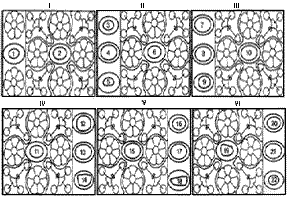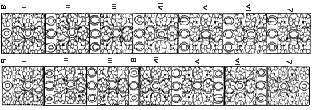|
|
|
The gems of the Iron Crown.
|
| Let's discover some of the mysteries of this precious object conserved in the Monza's Cathedral. |
|
|
|
 |
|
Drawing #1 arrangement of the gems
|
|
|
|
 |
|
Drawing #2 arrangement of the plates
|
|
|
|
|
Among the goldsmith's objects of the Dark Ages, the Iron Crown holds an important position for historical tradition and for the symbolical-religious meaning, but, as counterpart, it has a persistent uncertainty about the original source and destination. The lack of direct evidence leaves plenty of room to the studiouses to allocate its fabrication date between the Vth and the IXth century b. C., and to believe that it was now a royal crown, now a votive crown, or even a collar or a bracelet. The absence of a documented scientific analysis, for the materials, needs to be added to the lack of evidence above mentioned. The inner metallic circle of a gray color, believed to be iron, waits appropriate analysis after that LIPINSKY (1985) found that it doesn't attract the magnet; also the gold's title and the enamels nature haven't been subjects of researches, and finally the gems have been always identified with empirical methods and with traditional names. The lack of suitable surveys of an important object like the Iron Crown doesn't have to surprise, because shows a common situation to many other objects of the Italian historical-artistic patrimony, for which the specific literature is particularly miser of certain data. In too many catalogs, museum and exhibition brochures we read daring identifications of gems that have in common with the names given to them only the color. It would be nice if the empirical diagnosis would be substituted by generic words like "colored gems" or "azure gem" ect.
In the ambit of more accurate researches on the Monza's Cathedral Treasury initiated by Roberto Conti, keeper of the same museum, it was possible to activate an extensive program of gemological investigation on all the extraordinary complex of mediaeval goldsmith that it's kept there. As it is known, the Iron Crown is made of six rectangular plates linked between them by the short side, lightly curved and by almost exact dimensions: their height appears of 5.3 cm and their length varies from 7.9 to 8.4 cm. |
|
|
The twenty-two gems mounted in it are arranged according to two different frameworks.
- A) Five plates show the following drawing: one sector that is almost a square (6 x 5.3 cm) with a central gem surrounded by four gold rose windows set by fits and stars inserted with four irregular areas of cloisonné enamels portraying stylized flowers, along sided with a rectangular sector (2 x 5.3 cm) with three gems mounted in a vertical succession.
- B) One plate with the sector almost a square like above, along sided by a rectangular sector with an only central gem with above and below two gold rose windows
We can notice that currently the framework (A) presents three plates with the rectangular sector on the right and two plates with the rectangular sector on the left and that the framework (B) is sinistrorse. Obviously turning upside down the Crown the relations, consequentially change. The plates have been numbered from I to VI and the gems from 1 to 22 like it is shown in the drawing 1 and 2.
It is also known also how aren't really reliable the diagnosis of mounted gems, especially when the visible part of the stone is reduce to minimum and the cleaning is scarce. Even in the case it isn't a double stone, it's always impossible to observe important data, like the specific weight, to observe easily the inclusions and to obtain good reading of the refraction index.
If then the object is delicate or simply bulky, the difficulties increase and the identification risks to be based on unreliable elements. This is the case of the Iron Crown, where it didn't seem correct to proceed to the removal of the stones, even if this would have given better gemological results. This inconvenient was remedied by using illumination with high power fiber optics that allowed in a satisfactory way to deal with the following problems:
-The exploration of the stone's inside, almost every time included inside semi-occluding settings, for the mapping of the inclusions and of the back surface of the stones, so to eventually highlight the presence of colored supports;
-The implementation of spectroscopic observations, essential sometimes for a definite diagnosis;
-The reading of the pleochroism with the calcite dichroscope. Besides the FO light, the spectroscopy, and the dichroscope, the instrumentation included a microscope, a refractometer, and a UV rays lamp (short and long waves).
End of the first part (Continues)
|
|
|
|
 |
From left to right:
1 (garnet)
2 (garnet),
3 (quartz)
4 (garnet) |
|
 |
From left to right:
11 (garnet),
12 (corundum),
13 (garnet),
14 (corundum),
15 (corundum),
16 (glassy paste) |
|
|
 |
From left to right:
5 (quartz),
6 (glassy paste),
7 (corundum),
8 (garnet),
9 (corundum),
10 (glassy paste) |
|
 |
From left to right:
17 (garnet),
18 (corundum),
19 (corundum),
20 (quartz),
21 (glassy paste),
22 (quartz) |
|
|
|
|
|
|
|
|
|
|
|





